If you run a service business, then your customers “work” for you in many of the same ways your employees do. You essentially don’t know which people are on your team, when they’re showing up, and what they’re going to do once they get there. You need a plan for managing this uncertainty.
Service customers don’t just purchase a service; they participate in creating it. They can make your service faster or slower, better, or worse, cheaper, or more expensive to deliver—for themselves and other customers. They actively produce (and detract) from the value they consume.
A salad bar customer affects the quality of his or her meal, whereas patients who skip dental appointments drive up the costs of running the entire practice. When customers are influencing the service experience like these, they’re called customer operators.
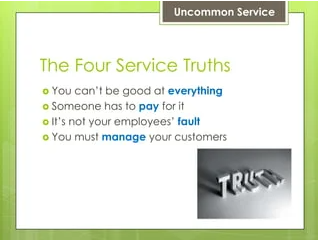 Customers can be involved operationally, depending on your industry and your specific design choices.
Customers can be involved operationally, depending on your industry and your specific design choices.
The more dependent your service business is on the behavior of customer operators, the more important it is to manage them successfully. Like employee management, the four components of a successful customer management system are customer selection, training, job design, and performance management.
Not all customer-operators are alike. When compared with each other, they are faster, slower, smarter, pickier, later, earlier, or prepared to perform their operational roles. This diversity increases the cost and complexity of running a service business.
Assume that you don’t know exactly how your customers are affecting your operations or how well your efforts to manage them are going. Reframe any certainties as hypotheses that need confirmation.
Authors Frances Frei & and Anne Morris of Uncommon Service: How to Win by Putting Customers at the Core of Your Business recommend testing them. The data you need is usually right at your fingertips.
Customers (Your Unpaid, Untrained, Unmotivated Employees)
Employees are contractually bound to work on behalf of your firm, but customers operate under no such constraints. Customers look out for number one, as they have every right to do.
On the plus side, customer operators require no salary, benefits, or retirement contributions, and they show up precisely when service is required.
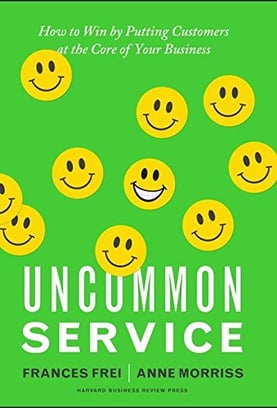 They also have a level of insight into their tastes and quirks—insight that your employees won’t ever have, even after throwing a fortune at market research.
They also have a level of insight into their tastes and quirks—insight that your employees won’t ever have, even after throwing a fortune at market research.
These factors suggest there’s a lot to be gained by empowering customers to play a greater role in meeting their own service needs.
Customers outnumber employees by orders of magnitude in most companies.
Service managers are inundated with variability, in the form of customer operators who are a little bit different from the last one who showed up—a little faster, slower, smarter, pickier, later, earlier, or more or less prepared to do the job.
In a service business, you essentially don’t know which people are on your team, when they’re showing up, and what they’re going to do once they get there.
You need a plan for managing this uncertainty.
Managing the Chaos of Customers
Variability is a fact of life with customer-operators. Here are the different forms it can take:
Arrival: Your customers don’t all want service at the same time or at times that are necessarily convenient for you.
Request: Not everybody orders the same thing.
Capability: Customers have different knowledge, skills, physical abilities, and resources, meaning some customers perform tasks easily while others need handholding.
Effort: Customer operators decide for themselves how much effort to invest in production tasks.
Preference: Even customers who want the same service may have very different definitions of quality.
Knowing which type of variability you’re dealing with can help you to manage it more effectively.
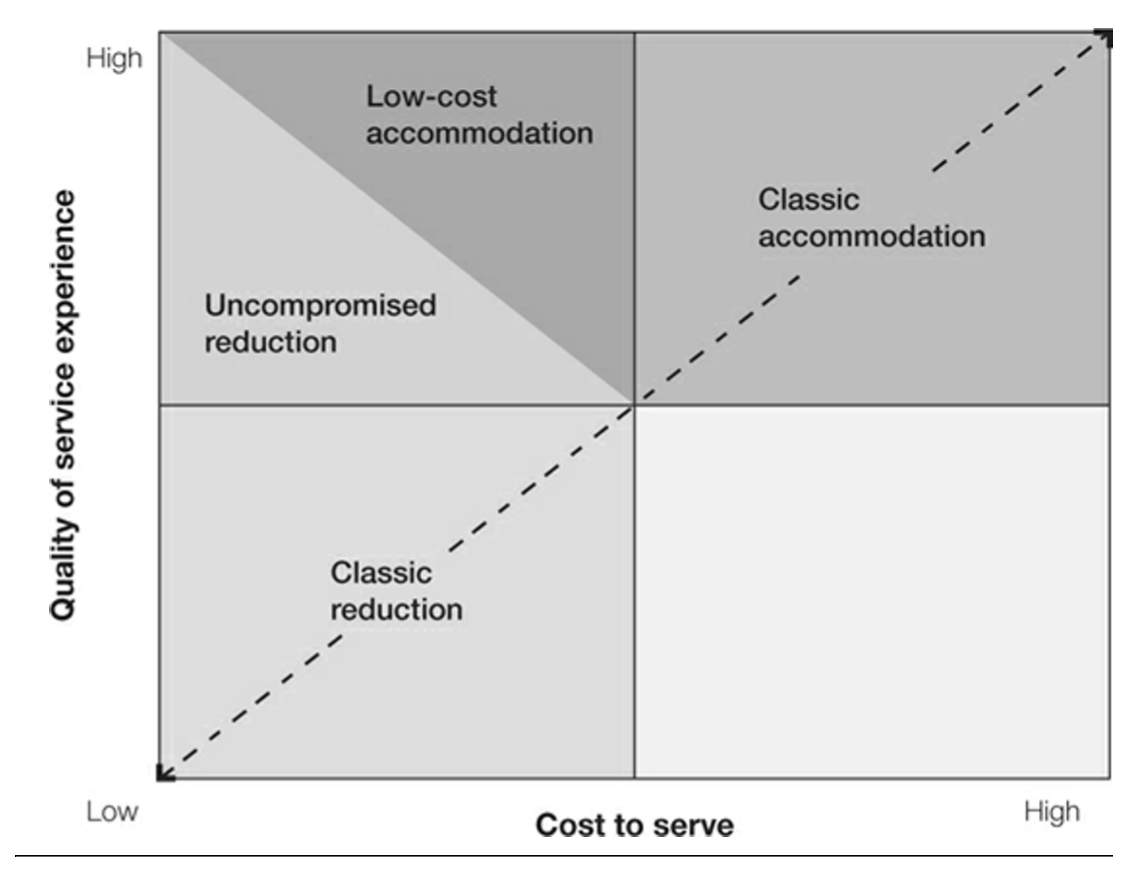 You can manage customer chaos in essentially two ways: by reducing or accommodating it (figure 4–1).
You can manage customer chaos in essentially two ways: by reducing or accommodating it (figure 4–1).
Reduction tends to favor efficiency. Accommodation tends to favor service, which keeps the two approaches in constant tension.
Classic reduction strategies are menus and reservations.
Limit your customers’ options—a win for you, but a loss for your customers, who may crave something off-menu.
Accommodation usually involves putting slack into the system and retaining a bench of experienced employees who can skillfully adapt to the chaos that customers bring with them.
This approach is expensive. As a result, accommodation often hinges on getting customers to pay a premium, not always an option for your business.
Successful Customer Management System
Customer Selection
For most companies, screening customers usually means checking their credit, not evaluating their fit from an operational perspective.
This is precisely what many service companies should be doing.
Progressive Insurance is just as selective as Stanford University or MIT in choosing the customers it wants to do business with.
Consider all the resources you invest to hire good employees: interviews; background checks; references; tests for ability, motivation, and cultural fit.
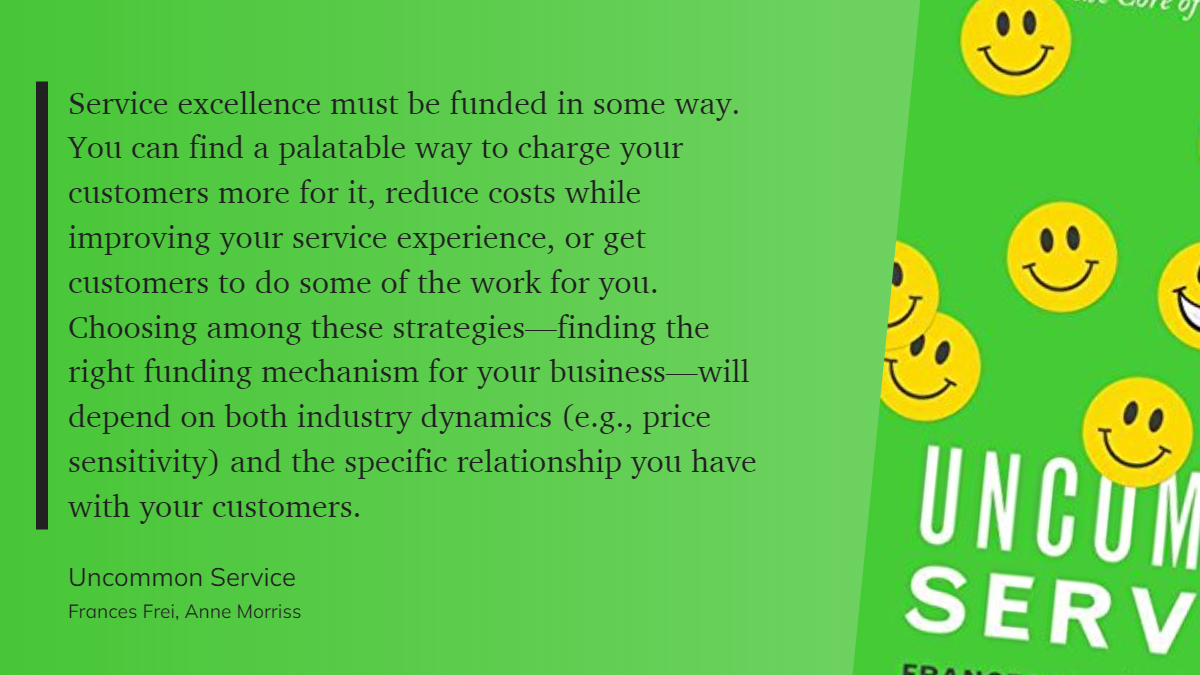 Now think of the energy you invest in “hiring” the right customers.
Now think of the energy you invest in “hiring” the right customers.
In most companies, there’s no comparison. Yet customer behavior has as much operational impact as employee behavior.
Your customers play a defining role in your ability to deliver great service at a sustainable cost. The greater your expectations for your customer-operators, the more time you need to dedicate to choosing the right people for the job.
Customer Training
At Starbucks, customers have little awareness of being trained, even though it’s a central part of the Starbucks service model.
Starbucks discovered customers who went with their gut while ordering confused the baristas and destroyed the speed of service.
Starbucks trained customers to order Starbucks drinks.
Training includes a helpful booklet; you can take it home and study.
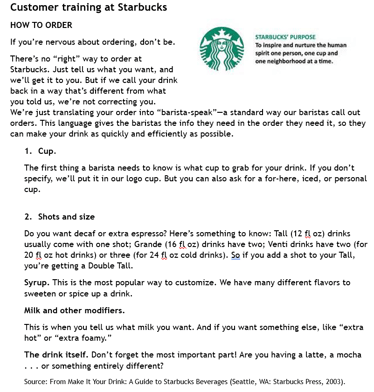 The booklet serves another purpose as well, the heart of the Starbucks customer training strategy: a program of subliminal influence that involves repeating orders back in Starbucks-speak.
The booklet serves another purpose as well, the heart of the Starbucks customer training strategy: a program of subliminal influence that involves repeating orders back in Starbucks-speak.
The protocol teaches customers the right way to do it, and everyone else in line overhears the tutorial.
The Starbucks example spotlights the attributes of a good customer-training experience: quick, easy, and palatable, if not downright fun.
Your training program must feel good to customers, whose tolerance for discomfort is low, despite any well-earned fantasies you might have of becoming Seinfeld’s iconic Soup Nazi, a service provider who gets his customers to behave by screaming at them.
Customers generally aren’t willing to give up their dignity as a cost of your service, unless your soup is that good.
Most companies can’t afford to intimidate their customers. Nor can they afford to confuse them.
Customer Job Design
Managers routinely make the same mistake many companies do: expecting customers to be as skilled as employees.
Some firms place an even larger operational burden on customers than they do on their employees.
 This happens a lot with self-service models, when untrained customers are asked to perform the same role trained employees once did.
This happens a lot with self-service models, when untrained customers are asked to perform the same role trained employees once did.
Freis and Morris tell companies when thinking about giving their customers more work: “Think airline kiosk check-in, not supermarket checkout.”
Be deeply thoughtful about what you’re asking your customers to do.
Managing Customer Performance
Customer operators shouldn’t be left entirely on their own, any more than employees should.
Companies regularly try to encourage customer cooperation through discounts and late fees, often with frustrating results.
The Blockbuster business model was dependent on customer compliance.
It was an uphill battle. Studies show instrumental methods such as fines for being late give consumers a sense of entitlement.
“OK, I’m compensating the company for my transgression,” many conclude. “It’s a fair exchange.”
Netflix overcame the customer operating problems that had plagued Blockbuster. Central to their model was a customer-operator role requiring little persuasion or enforcement.
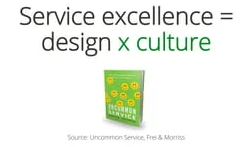 The Netflix customer paid a monthly fee to keep a certain number of DVDs in circulation. The moment you send one back, the company sends you another one, keeping your supply of disks at the level of your contract.
The Netflix customer paid a monthly fee to keep a certain number of DVDs in circulation. The moment you send one back, the company sends you another one, keeping your supply of disks at the level of your contract.
But you can’t get more without returning what you have, a powerful incentive to send the inventory back.
How do you put this into practice? That’s our next blog.
To create an environment where everyone is inspired to give their best, contact Positioning Systems to schedule a free exploratory meeting.
Turn your team into a growth organization.
Growth demands Strategic Discipline.
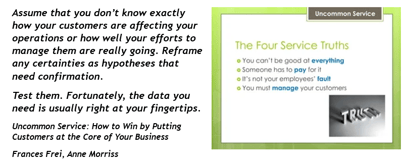 Embrace your customers. Put these principles into Practice, by getting control, actively involving customers, and providing customers with a meaningful role. Next blog, how to change your customers’ behavior.
Embrace your customers. Put these principles into Practice, by getting control, actively involving customers, and providing customers with a meaningful role. Next blog, how to change your customers’ behavior.
Building an enduring great organization requires disciplined people, disciplined thought, disciplined action, superior results, producing a distinctive impact on the world.
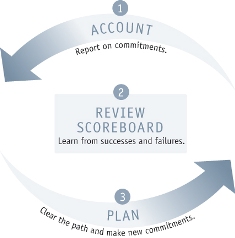 Discipline sustains momentum, over a long period of time, laying the foundations for lasting endurance.
Discipline sustains momentum, over a long period of time, laying the foundations for lasting endurance.
A winning habit starts with 3 Strategic Disciplines: Priority, Metrics, and Meeting Rhythms. Forecasting, accountability, individual, and team performance improve dramatically.
Meeting Rhythms achieve a disciplined focus on performance metrics to drive growth.
Let Positioning Systems help your business achieve these outcomes on the Four most Important Decisions your business faces:
|
DECISION |
RESULT/OUTCOME |
|
PEOPLE |
|
|
STRATEGY |
|
|
EXECUTION |
|
|
CASH |
|
Positioning Systems helps mid-sized ($5M - $500M+) businesses Scale-UP. We align your business to focus on Your One Thing! Contact dwick@positioningsystems.com to Scale Up your business! Take our Four Decisions Needs Assessment to discover how your business measures against other Scaled Up companies. We’ll contact you.
NEXT BLOG – Change Your Customers Behavior – Service Truth #4 Continued.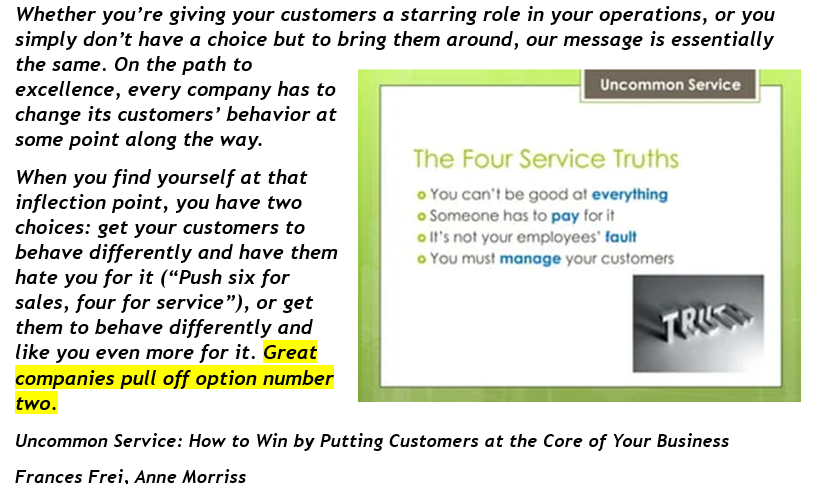






.jpeg?width=150&height=135&name=Hand%20with%20marker%20writing%20the%20question%20Whats%20Next_%20(1).jpeg)

